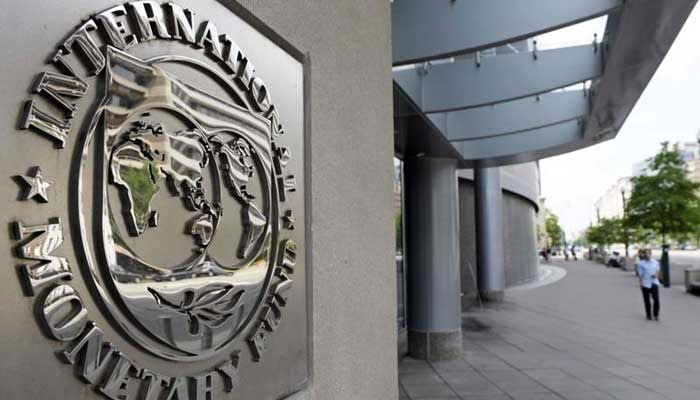IMF loan program pivots to growth from stabilisation: SBP
KARACHI: International Monetary Fund’s (IMF) loan program for Pakistan is shifting its focus to growth from stabilisation measures as the economy has stabilised, the central bank’s governor said on Tuesday.
“The IMF program right now is in a stage of pivoting from stabilisation to growth. Pakistan has successfully demonstrated that it has stabilised,” the State Bank of Pakistan (SBP) Governor Reza Baqir said in an interview to Bloomberg Television.
The economic growth has been projected at 3.9 percent for the current fiscal year and the foreign exchange reserves are reaching to four years high.
Baqir said the current account deficit touched the $19 billion mark in 2018/19 but in the first three quarters of the current fiscal year it has converted to a surplus of $900 million.
The State Bank’s forex reserves were $7.2 billion when the IMF program was started. Today, they are in the range of $16 billion.
“The increase is more than double the starting amount and this is also the increase in net international reserves meaning that these reserves have been drawn not by borrowing but high-quality measures,” he said. “Now pivoting to growth is critical for any national economic program because you have to demonstrate that the gains of stabilisation are going to come to the people in the form of growth. That is the stage where we are. And I think the 4 percent revised forecast of growth demonstrates that this policy has been successful.”
Pakistan's government has set a 4.8 percent GDP growth target for the next fiscal year as the country recovers from the coronavirus pandemic woes.
Baqir said the central bank has upgraded its economic growth projection to 3.9 percent for FY2021 after seeing the data particularly on farm output because agriculture is a big part of the country’s economy.
He said the growth forecast comes upon a combination of two factors. The first is the very aggressive central bank’s stimulus of about 5 percent of gross domestic product (GDP) largely relying on quantitative measures.
The second was a very prudent recalibration of government spending on the part of the fiscal authorities which injected a lot of cash in Ehsas emergency cash program. But it curbed the fiscal deficit because Pakistan already had a high level of public debt. Therefore, it supported market sentiment as investors saw that unlike emerging markets where on average the public debt to GDP grew by about 10 percent of GDP. In Pakistan it was broadly unchanged in 2020.
Baqir said for a country that had macroeconomic imbalances previously, this calibrated response by a combination of prudent fiscal and aggressive monetary policy is one of the key factors that underpins the economic turnaround and the increase in growth to about 4 percent.
The SBP governor said the SBP announced a forecast for inflation several months ago at 7 to 9 percent on average for this fiscal year that closes at the end of June.
“Our most recent estimate is that it will be close to the top end of the 7-9 percent range and we now think if we end up on average closer to 9 percent. The most recent inflation is around 11 percent and few months ago it was around 6 percent,” he said. “We decomposed this and found that three quarters of this increase in inflation recently is concentrated in just a handful of commodities or consumer price index groups pertaining to energy and food. So we largely see this as one off but we are prepared to take any action if there are signs of demand pressure but currently we don’t see any.” Baqir said the monetary policy committee (MPC) met on Friday and it essentially made three points. First is the monetary stance right now in Pakistan is significantly accommodative.
The policy rate is 7 percent and depending upon the measure of inflation but the backward looking, forward looking headline or core, real interest rates range from about zero to minus 4 currently.
The second key point was that the MPC decided to leave rates unchanged. And the key considerations behind this decision were the uncertainties related to COVID.
The fact that has increased the headline inflation recently primarily pertains to energy and food prices which are likely to be one off.
The third key point from the meeting of the MPC pertained to forward guidance and the committee was of the view that in the absence of unforeseen circumstances the current significantly accommodative would be maintained. If there are any signs of emerging demand side pressure then the committee may decide to moderate the extent of the current accommodative stance, the SBP’s governor said.
-
 Do You Have Depression Or Is It Just Monday Blues? Find Out Where Science Stands
Do You Have Depression Or Is It Just Monday Blues? Find Out Where Science Stands -
 Why Claude Is Gaining Momentum In Revolutionizing The AI Landscape
Why Claude Is Gaining Momentum In Revolutionizing The AI Landscape -
 Elon Musk Unveils Plans To Take Humanity To The Moon And Mars
Elon Musk Unveils Plans To Take Humanity To The Moon And Mars -
 Air Pollution May Play A Role In Prostate Cancer Risk, Experts Warn
Air Pollution May Play A Role In Prostate Cancer Risk, Experts Warn -
 Royal Expert Reveals Real Reason King Charles Won't Meet Prince Harry Next Week
Royal Expert Reveals Real Reason King Charles Won't Meet Prince Harry Next Week -
 Ansel Elgort Welcomes His First Baby In Secret
Ansel Elgort Welcomes His First Baby In Secret -
 Startup Aims To Brighten Night Skies With Space Mirrors
Startup Aims To Brighten Night Skies With Space Mirrors -
 Cheaper Cars, Fewer EVs: Trump Administration Shifts ‘auto Policy’ Focus
Cheaper Cars, Fewer EVs: Trump Administration Shifts ‘auto Policy’ Focus -
 Meghan Markle Takes 'breadwinner' Role In Prince Harry's California Life
Meghan Markle Takes 'breadwinner' Role In Prince Harry's California Life -
 Type 2 Diabetes Hidden Trigger In Daily Food Revealed
Type 2 Diabetes Hidden Trigger In Daily Food Revealed -
 Vertical Tabs Coming To Google Chrome
Vertical Tabs Coming To Google Chrome -
 Jane Seymour Reveals THIS Beloved Romance Was 'worst-reviewed' Movie Ever
Jane Seymour Reveals THIS Beloved Romance Was 'worst-reviewed' Movie Ever -
 European Leaders Slam Trump’s Tariff Threat Over Greenland As ‘unacceptable’
European Leaders Slam Trump’s Tariff Threat Over Greenland As ‘unacceptable’ -
 Princess Eugenie Leaves Father Andrew 'devastated' With Big Step: 't's Brooklyn Beckham Level'
Princess Eugenie Leaves Father Andrew 'devastated' With Big Step: 't's Brooklyn Beckham Level' -
 Nova Scotia Snow Storm Warning Issued As Heavy Snow Moves In
Nova Scotia Snow Storm Warning Issued As Heavy Snow Moves In -
 Vancouver Canucks 2025-26 Season: Adam Foote’s Future Under Early Scrutiny
Vancouver Canucks 2025-26 Season: Adam Foote’s Future Under Early Scrutiny




